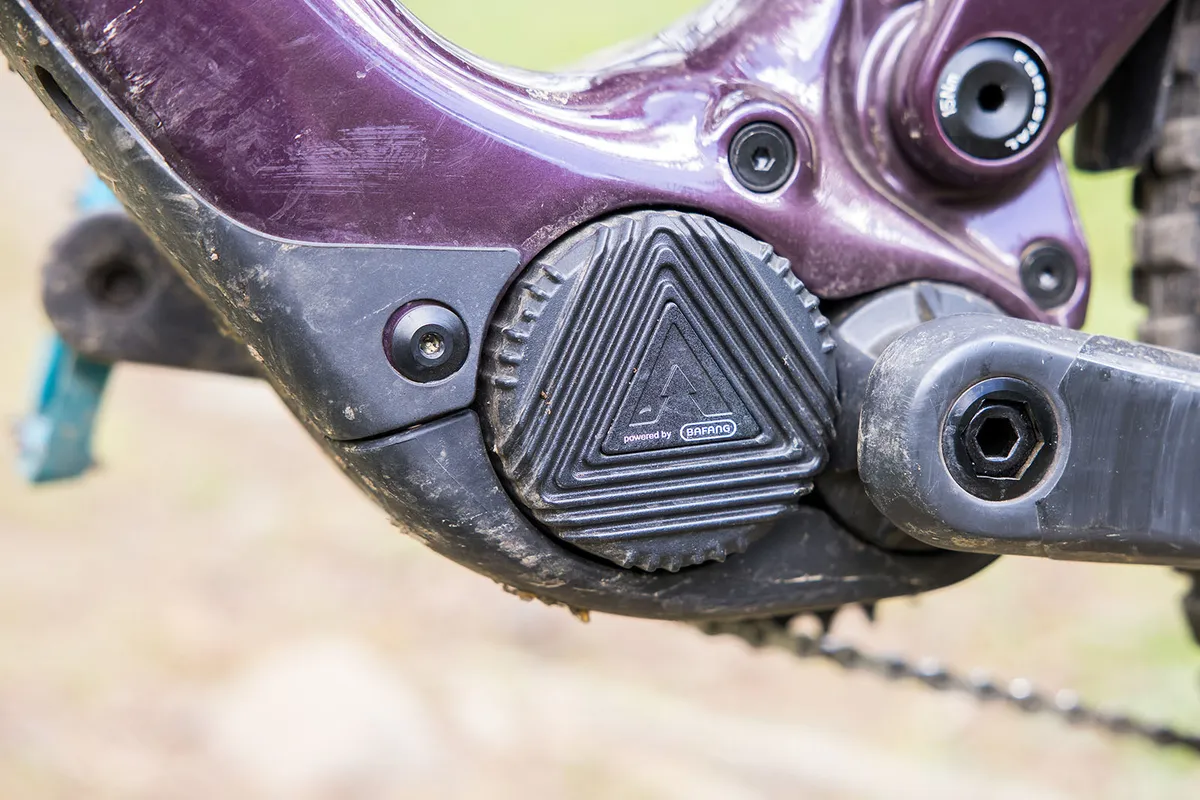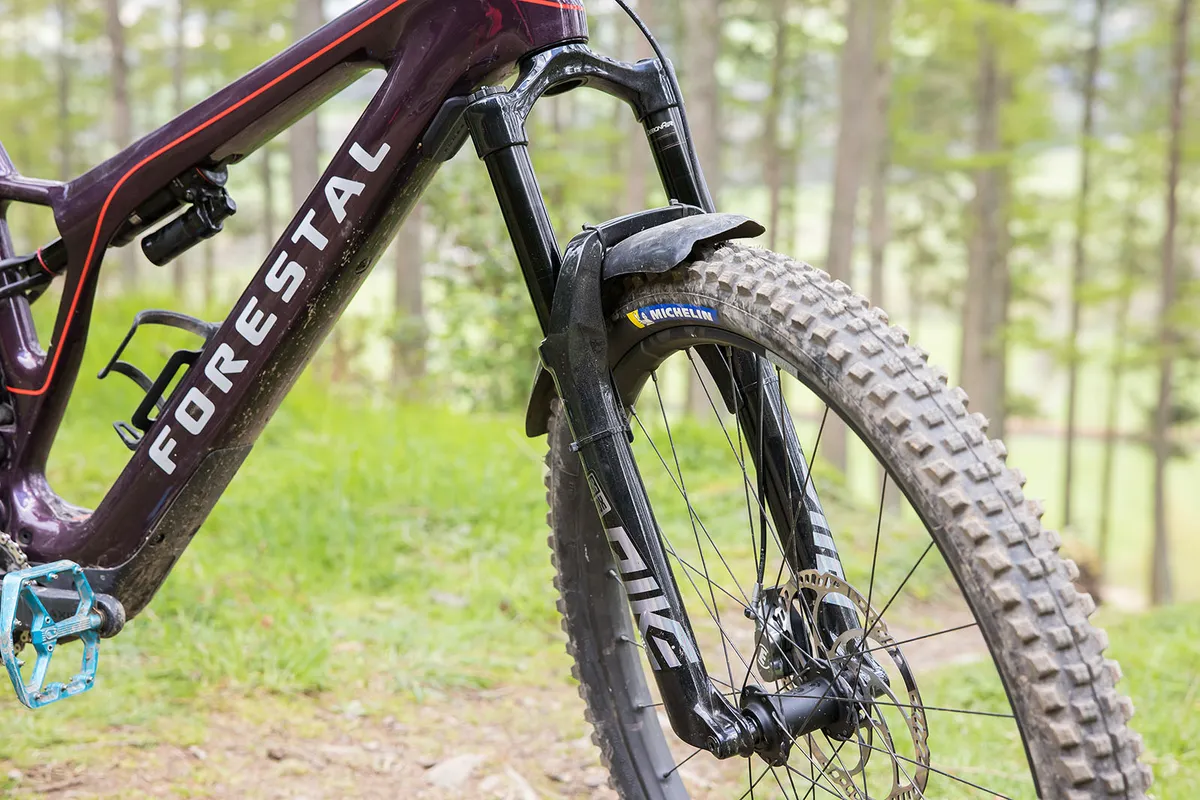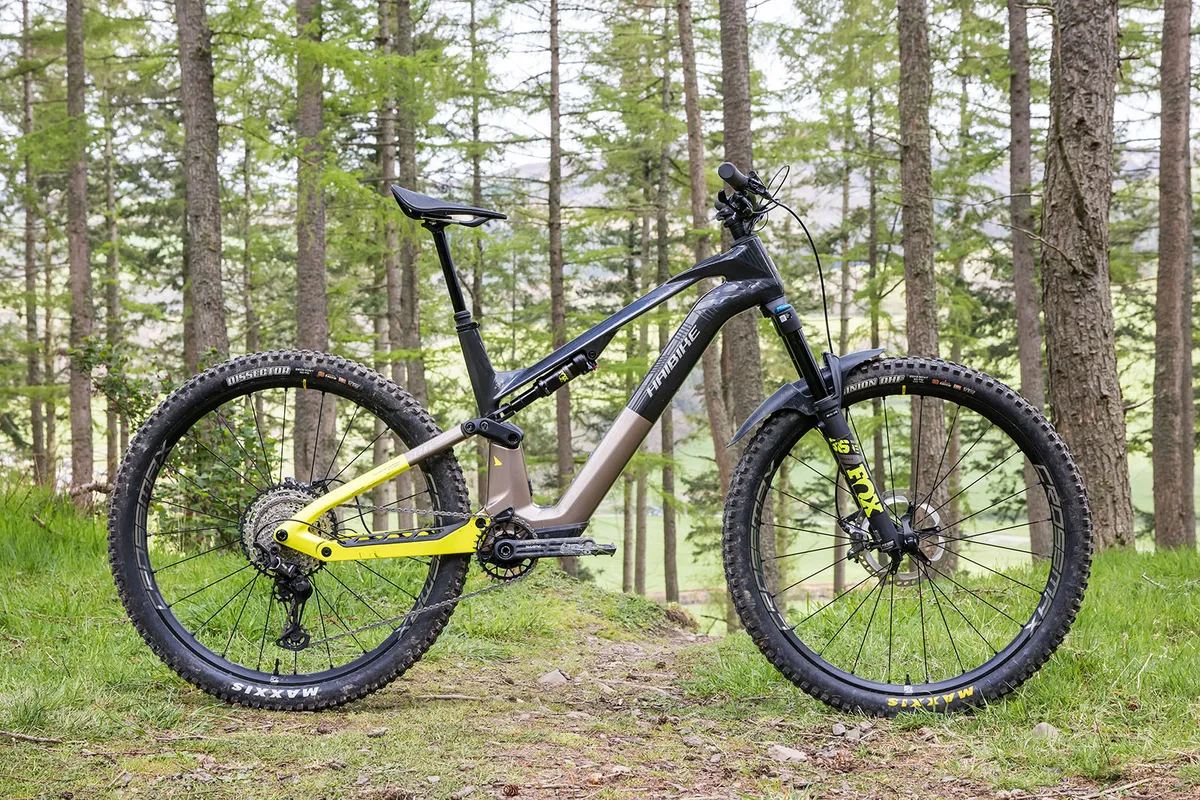Forestal’s Cyon is a trail-focused electric mountain bike with 150mm of front and rear-wheel travel, and 29in wheels.
The ebike-only Andorran brand uses the 60Nm EonDrive electric bike motor, built by Bafang, in the Cyon. It's controlled by a top-tube mounted full-colour touchscreen display.
The Neon sits in the middle of the three-bike Cyon range. The bikes share frames, motors and batteries – boasting Ultimate-level RockShox suspension, an X01 drivetrain and Crankbrothers' impressive Synthesis wheels. The Neon isn't cheap, however, costing £10,999.
With big 29in wheels, a lengthy reach, moderate head angle and a decent amount of travel, the Cyon sits comfortably in the trail bikes category.
Forestal Cyon Neon frame, suspension and motor

The Cyon’s carbon fibre frame is made from a blend of three carbon materials – T1000, T800 and T700 – with different tensile strengths to tune the frame’s rigidity, giving “comfort both uphill and downhill,” according to Forestal.
The Cyon’s front triangle is asymmetric, with a design akin to Specialized’s Sidearm. The rear swingarm's single-piece design is in contrast to the more traditional-looking front triangle (even if the Cyon’s rear end may be reminiscent of older Orange bikes with their single-strut, aluminium swingarms).
Forestal calls this design ‘Alpha Box’, and claims it improves performance while retaining the brand’s unique looks.

Cables are routed internally via ports in the headset. There’s an in-built chain device and bottle boss mounts inside the front triangle. Chain-slap protection features on the underside of the elevated driveside chainstay.
Suspension
Its 150mm-travel single-pivot suspension design uses a small linkage – dubbed ‘Twin Levity’ – to tune its kinematics specifically for trail riding. It provides, according to Forestal, a smooth and supple feel for a fast and active ride.
Motor and battery

Built into the frame’s top tube is Forestal’s touchscreen full-colour control panel. It has a plethora of in-built functionality such as GPS, WiFi, maps, ride recording and statistics.
Custom-developed software called the ‘Forestal Dashboard’ runs the onboard computer. It works entirely on its own or connects to the Forestal smartphone app via Bluetooth to increase functionality.
The mode controller has three buttons that are used to change between five modes; off, Walk, Eco, Sport, Race and Nitro.
The Bafang-built EonDrive motor is claimed to be completely disengaged from the drivetrain, providing zero drag when it’s off. When it’s on, it offers up to 60Nm of torque and 250W of nominal power. It has an IP67 water and dust-proof rating, and a 170mm Q factor.
Saving weight, it’s built from a mix of materials including titanium, and has a magnesium shell. Its claimed weight is 1.95kg.
Powering the motor is Forestal’s Aurora battery with a 360Wh capacity. It’s compatible with a 250Wh range extender that plugs directly into the charging port.
Forestal Cyon Neon geometry

Cyon’s geometry nestles it deeply in the trail bike category, with a 65.5-degree head tube angle, a 76.6-degree seat tube angle and reach figures that span from 430mm to 500mm in its four-size (S to XL) range.
Elsewhere, the small and medium bikes share a 435mm chainstay, while the large and extra-large sizes get a longer 445mm figure, helping maintain the front-to-back balance.
Forestal claims a 346mm bottom bracket height, but I measured my size-large test bike with a 338mm figure.
While not extreme, its geometry figures are well suited to its trail-riding intentions.
| | S | M | L | XL |
|---|---|---|---|---|
| Seat angle (degrees) | 76.6 | 76.6 | 76.6 | 76.6 |
| Head angle (degrees) | 65.5 | 65.5 | 65.5 | 65.5 |
| Chainstay (mm) | 435 | 435 | 445 | 445 |
| Seat tube (mm) | 415 | 430 | 465 | 500 |
| Top tube (mm) | 577 | 603 | 633 | 657 |
| Head tube (mm) | 95 | 100 | 110 | 125 |
| Fork offset (mm) | 42 | 42 | 42 | 42 |
| Bottom bracket drop (mm) | 30 | 30 | 30 | 30 |
| Bottom bracket height (mm) | 346 | 346 | 346 | 346 |
| Wheelbase (mm) | 1176 | 1203 | 1242 | 1268 |
| Stack (mm) | 611 | 616 | 625 | 638 |
| Reach (mm) | 430 | 455 | 480 | 500 |
Forestal Cyon Neon specifications

This mid-range Neon model has a specification worthy of its asking price.
Up-front is a 150mm-travel Charger 2.1 RockShox Pike Ultimate, paired with a Super Deluxe Ultimate RCT rear shock. SRAM X01 Eagle kit makes up the drivetrain, but with the tighter-ratio 10-50t cassette.
Magura’s MT7 brakes are matched with a 203mm rotor at the front and 180mm rear.

Crankbrothers provides both the dropper post – in the form of a Highline 7 with 150mm travel (size large) – and wheels from its Synthesis range, specifically the Carbon E7 variant.
These are wrapped in Maxxis tyres, with a 29x2.3in Minion DHF 3C MaxxTerra EXO up front and a High Roller II 3C MaxxTerra EXO 29x.2.3in out back, both skinnier than their Wide Trail counterparts.
Forestal takes care of the bars and stem, while Production Privee supplies the grips.
Without pedals, this size-large test bike weighed 18.49kg.
Forestal Cyon Neon ride impressions

I tested the Forestal Cyon Neon on a wide range of trails in Scotland’s Tweed Valley.
Ranging from enduro runs used for the enduro world cup, to routes at Glentress trail centre and all-day epics in the backcountry, I tackled every type of terrain any capable trail bike should be expected to handle.
Setup
Using Forestal’s online setup guide, I set the fork’s air spring to 107psi and added three volume-reducer spacers, giving me the recommended 20 per cent sag figure.
I left the externally adjustable compression damping fully open and set the rebound to taste.
During testing, I reduced spring pressure to 102psi to improve small-bump performance, increasing sag to 22 per cent.
I inflated the rear shock’s air spring to 185psi and left the stock single volume-reducer spacer installed. This gave me the recommended 25 per cent sag. During testing, I increased the low-speed compression damping by two clicks. I set the rebound to taste.
Because of the limited adjustment, the Magura brakes and SRAM Matchmaker X adaptors made it tricky to get the brakes, dropper lever and gear shifter set to my preferred position.
The mode controller, when placed within reach of my thumb, also prevented me getting the left-hand brake lever far enough outboard to reach comfortably.
A slimmer mounting point for the mode selector would help with cockpit setup, but not everyone will experience the same issues as me.
I swapped out the stock Maxxis tyres for a grippier compound and beefier casing in the form of the 2.4in Michelin Wild AM2.
Forestal Cyon Neon climbing performance

Riding uphill and on flatter sections of trail, the rear suspension’s lower-than-average sag recommendation gives it a sporty feel.
Although no harshness is reverberated through the bike, its ride isn’t the smoothest. The trail’s surface isn’t absorbed with luxurious accuracy or compliance, the suspension only taking the sting out of bigger bumps.
The sportiness of the bike’s feel is welcome when you put the power down, but for all-day epics over rough terrain a little more suspension compliance would help.
The frame and wheels mitigate this to an extent, thanks to their in-built flex, but not enough to totally smooth out trail buzz.

Positively, however, the firm suspension helps preserve the bike’s geometry on steeper ascents by not dipping too deep into its travel and slackening out the seat tube angle, resulting in a loss of comfort and efficiency.
Doing so improves comfort and pedalling efficiency, because your weight remains evenly distributed between the front and rear wheels, aiding traction and control by reducing front-wheel lift.
Excessive weight shifts aren’t needed, and it’s easy to feed plenty of its motor’s power into the back wheel without wheel spinning.
The seat tube angle feels good, but it’s not perfect. While your hips are almost above the bottom bracket, they could shift slightly further forwards.
Adjusting the saddle nose down and pushing it forward on the rails helps mitigate this to an extent, but isn’t as good as steepening the tube’s angle.

This creates an aggressive seated riding position. Your shoulders are naturally stooped towards the bars, which encourages you to push hard and drive through the pedals.
Unlike gravity-focused winch and plummet bikes, this seated position is befitting of the Cyon’s trail bike credentials.
SRAM’s 50t Eagle cassette – rather than the bigger 52t – and 32t chainring left me wanting more gears once the battery had died, especially on steeper climbs.
Motor performance and battery life

The EonDrive motor’s boot-up time is longer than all of the other ebike motors I’ve used in recent times, but plenty of functionality is provided for the extended wait.
In use, the small assistance icons are tricky to decipher at a glance, but the battery life percentage bar is very clear.
The Bafang motor is one of the punchiest-feeling SL ebike motors currently on sale in all its modes bar Nitro, where the Fazua’s boost function matches it comfortably. Eco is closer to the mid-level settings of other systems.
Battery life is impacted, however, especially in the higher settings. Using exclusively Eco, I managed 1,193 of ascent from a single charge, a chunk less than the next-least-frugal Specialized, and nearly 1,500m short of Fazua’s range.
While the screen appeared robust and well protected, water droplets activated it. In damp conditions, it had to be locked.
Although the remote’s small buttons were easy to find, the pressure required to activate them was high, making button presses feel vague.
The EonDrive is impressively powerful. Future software updates should increase functionality, potentially improving battery life. When, or if they come, the EonDrive will easily rival Specialized’s latest motor.
Forestal Cyon Neon descending performance

Despite running less sag than a lot of electric mountain bikes, the Cyon feels muted and forgiving on the downhills.
Although its suspension is contributing to some of this, the frame and wheels' in-built flex appears to be doing the heavy lifting.
Riding hard feels rewarding; pushing into the terrain is muted and soft, the frame and wheels helping to drive grip and control even on rough, choppy surfaces.
This takes the guesswork out of riding, where harsher bikes can have surprising and sudden drops in grip; not so with the Cyon.
In this respect, riding hard on the Cyon is easy and comfortable, and rider energy isn’t wasted trying to control unwanted sliding.

While the suspension isn’t the smoothest out there, the Cyon’s stiffer-than-average setup provides stability when it’s ridden hard, nullifying the harshest of bumps.
At slower speeds it’s not the most comfortable, however.
On the plus side, it resists eating into its travel too quickly when pushing confidently into turns or through compressions. It doesn’t wallow about in its mid-stroke; instead it’s much livelier and more active to ride, and also helps hide some of the Forestal’s weight.

There’s plenty of ramp-up deeper into its travel. Bottom-outs were infrequent, and very soft when they did happen.
As on the climbs, this helps preserve its dynamic geometry when heading down the trail.
The bar and bottom bracket stay more level with the horizon, and large, quick, reactive weight shifts aren’t needed to compensate for sudden changes in geometry caused by diving suspension.
The rear end’s performance and the overall speed potential of the frame significantly outgun the Pike’s chassis and spring.

Higher spring pressures are needed to prevent it from getting overwhelmed in higher-load situations, but this negatively impacts comfort and traction.
A burlier 36 or Lyrik fork would be better suited to the Cyon’s performance.
The hands-to-feet relationship is well balanced and proportioned, helped by the generous reach, average stack height, and low bottom bracket.
Thanks to the bottom bracket’s height, you feel in, rather than on the bike. This improves control and stability; the Cyon needs to be pitched significantly fore or aft before you feel you’re losing control.

It also translates to great turning control. Hooking around corners is balanced, and weighting both front and rear wheels evenly needs only a neutral stance.
The frame’s softness adds to the feeling, and grip is abundant.
Driving the front wheel hard for grip on steeper trails highlights the fork’s weaknesses again.
The seat tube feels tall, though, with the saddle frequently contacting my backside on descents or when I squatted low on the bike in turns.
A longer-travel, lower stack height dropper, such as OneUp’s V2, would reduce this problem.
Crucial tyre swap

The stock Maxxis Minion DHF EXO casing 3C MaxxTerra 2.3in front tyre and High Roller II EXO casing 3C MaxxTerra 2.3in rear tyre aren’t suited to the rigours of hardcore trail riding, let alone the increased weight of SL ebikes.
Their 2.3in width – which is narrower than Maxxis’ Wide Trail casings – hinders performance further, because the lower-volume rubbers need even higher pressures to retain carcass stability and resist punctures, and they aren’t as forgiving as higher-volume tyres.
Before testing started, I asked the UK’s Forestal distributor to supply some better tyres for the Cyon, settling on Michelin Wild AM2 2.4in rubber, costing £69.99 a tyre.
With casings equivalent to Maxxis’ EXO+, the Wild AM2 tyres have proven to be faultless during the test period, enabling me to fully explore the performance potential of the Cyon.
This highlights the need for appropriate rubber; the wrong mountain bike tyres can ruin a bike’s performance and potentially sour your purchase.
How does the Forestal Cyon Neon compare to the Haibike Lyke 11?

Although disparate in cost (£6,799 vs. £10,999), the Lyke and Cyon are matched closely in performance, geometry and suspension figures.
Both are designed for trail riding, but thanks to thoughtful and balanced geometry, each can be pushed harder, tackling tough enduro tracks, albeit slower than more progressive bikes.
With the additional asking price of the Forestal comes plusher kit. Most notable are the Ultimate-level dampers, offering more adjustment than the Fox kit fitted to the Lyke.
Carbon Synthesis hoops have an arguably more premium feel than the Mavic E-Crossmax on the Haibike, and offer a smoother, plusher ride.
Both bikes have carbon frames, but the Forestal’s built-in computer and display is leagues ahead of Fazua’s LED controller.
However, battery life swings considerably in favour of the Fazua motor, and even at the top end, this more economical motor is just as powerful as the Bafang.
Many will prefer the high-tech feel of the Forestal, but in terms of price versus performance, it’s hard to argue against the Fazua-powered Lyke.
The Cyon is lighter at 18.49kg, compared to the Lyke’s 19.31kg, but you’d hope so given the cost difference.
Which one is right for you will ultimately come down to budget. While more expensive Haibike models are on offer, as are cheaper Forestals, they’re different propositions; one is a boutique brand from Andorra, the other a more mainstream offering from Germany.
Forestal Cyon Neon bottom line

Forestal’s Cyon Neon – after the essential tyre upgrade – performed impressively on the trails, with its suspension opening up a wider performance range than its trail-focused geometry would suggest.
In fact, when the trails got gnarly its soft-feeling chassis, supportive kinematic and sporty sag setup all played in its favour, creating a stable platform to attack from.
Slow down, or spend all day trundling over rough, bump surfaces and it’s less enjoyable than other bikes on the market, but you can always reduce spring pressure to soften things up a bit.
Being picky, the seat tube angle could be steeper on the climbs, the head tube angle could be slacker for the descents, but the Cyon’s figures encapsulate the ethos of a trail bike.
The motor’s power is punchy, but battery life suffers because of it. Hopefully, a future software update will address this.
If you want a boutique carbon frame with an innovative user interface, the Forestal is a solid performer.
SL ebikes | How we tested
With their jack-of-all-trades attitude, SL ebikes have to perform well everywhere, so we were looking for adaptability, range and power out on the trails.
Senior technical editor Alex took to his local runs in Scotland’s Tweed Valley to push them to their limits, finding out which ingredients make the perfect lightweight eMTB.
Bikes tested
- Focus JAM2 SL 9.9
- Forestal Cyon Neon
- Haibike Lyke CF 11
- Specialized S-Works Turbo Levo SL II
Product
| Brand | Forestal |
| Price | €11799.00, £10999.00 |
| Weight | 18.49kg |
Features
| Fork | RockShox Pike Ultimate Charger 2.1, 150mm travel |
| Stem | Forestal Oxydon, 45mm |
| Chain | SRAM X01 Eagle |
| Frame | Carbon fibre, 150mm travel |
| Motor | Forestal EonDrive motor, 360Wh Aurora Performance battery, Forestal Smart Dashboard display, Forestal Smart Trigger |
| Tyres | Maxxis Minion DHF 3C MaxxTerra EXO 29x2.3in (f), Maxxis High Roller II 3C MaxxTerra EXO 29x2.3in (r) |
| Brakes | Magura MT7, 203/180mm Galfa rotors |
| Cranks | Paxis Carbon, 32t |
| Saddle | Fizik Aidon X3 |
| Wheels | Crankbrothers Synthesis Carbon E7 |
| Headset | Acros Integrated |
| Shifter | SRAM X01 Eagle |
| Cassette | SRAM Eagle XG-1295, 10-50t |
| Seatpost | Crankbrothers Highline 7 (dropper) |
| Grips/tape | Forestal X Production Privee Edition |
| Handlebar | Forestal Oxydon C, 780mm |
| Rear shock | RockShox Super Deluxe Ultimate RCT |
| Available sizes | S, M, L, XL |
| Rear derailleur | SRAM X01 Eagle (1x12) |
